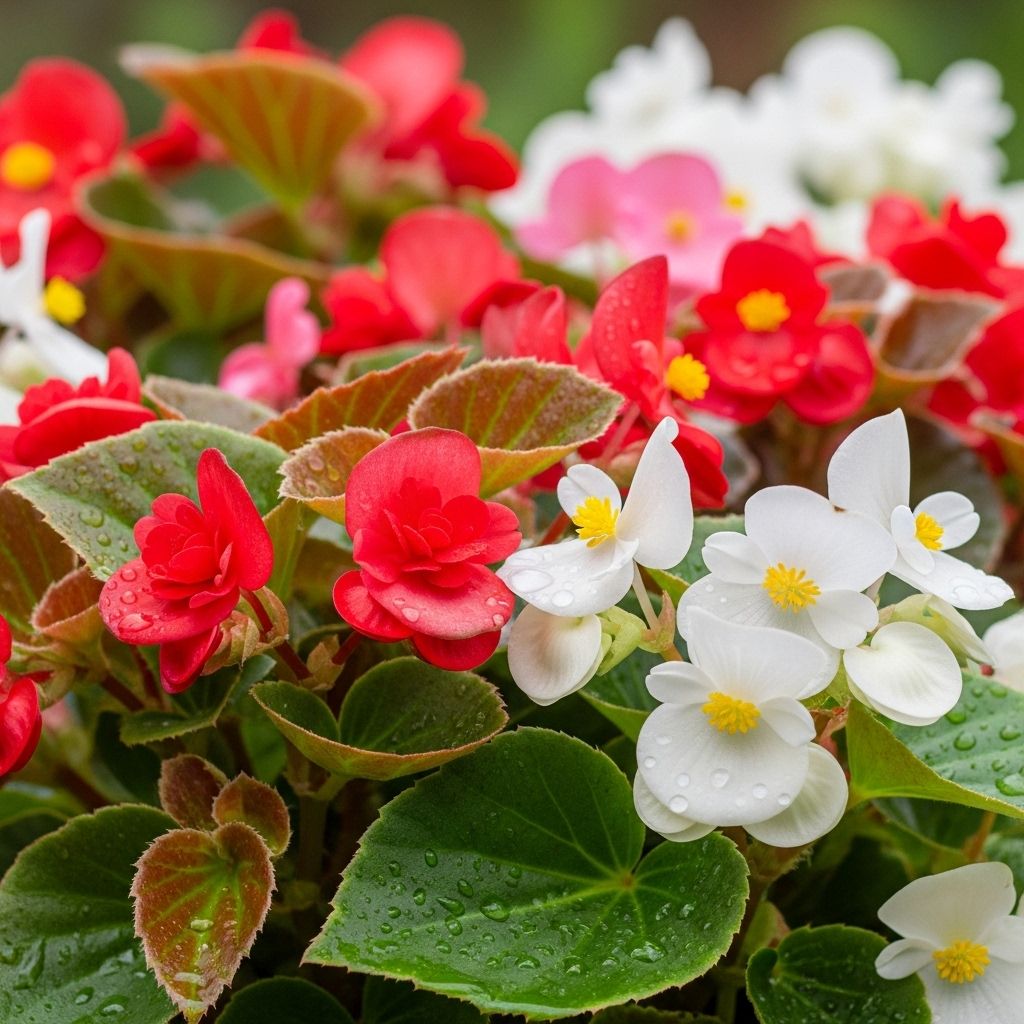Wax Begonia Care: 5 Expert Tips For Lush Blooms
Discover thriving secrets and expert tips to nurture vibrant blooms year-round effortlessly.

Image: HearthJunction Design Team
Wax Begonia: Planting, Care, and Growing Guide
Wax begonias (Begonia x semperflorens-cultorum) are beloved for their compact growth, glossy foliage, and continuous flower show in shades of white, pink, and red. Whether you’re a seasoned gardener or new to flowering beds, this guide will help you plant, care for, and enjoy wax begonias both outdoors and indoors.
Table of Contents
- About Wax Begonias
- Planting Wax Begonias
- Wax Begonia Care
- Growing Wax Begonias Indoors
- Pests and Disease Management
- Landscape and Design Ideas
- Frequently Asked Questions
About Wax Begonias
Recognizable for their waxy leaves and continuous flowers, wax begonias are among the most popular bedding plants for gardens and containers. Available in both green and bronze-leaf varieties, they are renowned for their:
- Compact mound shape, reaching 6-12 inches in height and width
- Foliage ranging from fresh green to deep bronze hues
- Showy clusters of flowers in white, pink, or red
- Ever-blooming habit from late spring into fall
- Tolerance to sun, shade, and drought once established
Wax begonias are
annuals in most climates but may be grown as perennials or overwintered indoors in frost-free zones.
Planting Wax Begonias
When and Where to Plant
- Best Time: Wait until all danger of frost has passed, typically mid-May or later, before transplanting wax begonias outdoors.
- Site Selection: Choose a spot with partial shade to filtered sun. Bronze-leaf varieties tolerate more direct sun; green-leaf types prefer some shade.
Planting Steps
- Prepare soil by loosening to a depth of 6-8 inches and mix in organic matter for improved drainage and nutrients.
- Space plants about 8-10 inches apart for bedding designs, or 12 inches apart for larger varieties. This ensures good air circulation and prevents overcrowding.
- Dig planting holes slightly larger than the root ball. Set plants at the same depth as in their containers.
- Water thoroughly after planting, but avoid waterlogging.
- Mulch lightly to retain soil moisture and suppress weeds.
Design Ideas
- Plant in masses for a dramatic, colorful display—combine different flower and foliage colors for patterns or motifs.
- Use as borders, in containers, or mixed with other annuals.
- Excellent for planting on graves or spots needing low-maintenance continuous blooms.
Wax Begonia Care
Watering
- Wax begonias have thick, succulent-like stems and leaves, making them drought-tolerant once established.
- Water about 1 inch per week, letting the soil dry slightly between waterings.
- Overwatering leads to root rot and mushy stems—avoid soggy soil at all times.
- For containers, water when the top 1–2 inches of soil feel dry and ensure pots have drainage holes.
Fertilizing
- Feed with a balanced, water-soluble fertilizer once a month during the growing season or use slow-release fertilizer at planting time.
- Organic mulch can be applied after planting to help conserve soil moisture.
Pruning and Deadheading
- Pruning is rarely needed due to the naturally tidy, mounded shape.
- Pinch back stems if plants become leggy or to encourage bushiness.
- Wax begonias are self-cleaning—no need to remove spent flowers for repeat blooms.
Winter Protection & Overwintering
- To preserve begonias over winter, bring them indoors before the first frost.
- Place in a bright, filtered light spot (avoid direct sun if previously shaded).
- Keep soil slightly moist and fertilize lightly throughout winter, as they do not go fully dormant.
- Return outdoors after last frost in spring.
Growing Wax Begonias Indoors
Light & Location
- Choose a spot with bright, indirect light; avoid harsh midday sun or dim north-facing windows.
Watering Indoors
- Allow the first half inch of soil to dry out before watering.
- Water thoroughly, allow the pot to drain completely, and never let the plant sit in excess water.
Fertilizing Indoors
- Feed with liquid fertilizer weekly at quarter strength or biweekly at half strength during the main growing season.
- Use a high-phosphorous fertilizer every third or fourth feeding for more blooms.
Pruning & Maintenance Indoors
- Trim back stems every few weeks to prevent legginess and promote new growth.
- Remove dead flowers and browning leaves to encourage health and appearance.
- Good air circulation is essential; use a gentle fan to simulate outdoor breezes and discourage fungal diseases.
Container Tips
- Use a pot only slightly bigger than the plant’s root ball; wax begonias prefer to be somewhat root-bound.
- Repotting is usually required once or twice during the plant’s lifespan.
- Ceramic containers with drainage holes work best.
Pest and Disease Management
Pests
- Mealybugs, spider mites, thrips, and whiteflies may appear—inspect plants regularly for signs of infestation.
- Treat infestations with insecticidal soap or neem oil when needed.
Diseases
- Powdery mildew and botrytis blight are the main issues; ensure good air circulation and avoid wetting foliage when watering.
- Remove affected leaves promptly to prevent spread.
General Tips
- Provide adequate spacing for airflow when planting en masse.
- Keep soil consistently moist but not soggy.
Landscape and Design Ideas
- Mass plantings for dense, colorful bedding displays
- Edging along walkways or borders
- Containers and window boxes for patios and balconies
- Mixed annual beds with impatiens, coleus, or dusty miller
- Memorial plantings—ideal for grave sites due to low maintenance and lasting color
Notable Wax Begonia Varieties
| Variety | Flower Color | Foliage | Notes |
|---|---|---|---|
| Surefire® Rose | Rose-pink | Green | Vigorous, self-cleaning, excellent for containers |
| Double Series | All colors | Bronze or green | Striking double blooms |
| Ambassador Series | Red, pink, white | Green | Compact, ideal for borders |
| Varsity Series | Red, pink, white | Bronze | Tolerates heat and sun |
Frequently Asked Questions (FAQs)
How often should I water my wax begonia?
Water about once a week outdoors, or whenever the top 1–2 inches of soil are dry. Indoors, let the top half inch dry before watering again. Avoid letting them sit in soggy soil.
Can wax begonias grow in full sun?
They perform best in partial shade. Bronze-leaf types tolerate more sun than green-leaf varieties, which may scorch in direct midday light.
Are wax begonias annuals or perennials?
They are perennial in frost-free zones but grown as annuals in most climates. You can overwinter them indoors for year-round growth.
Why are my begonia’s leaves turning yellow or brown?
Yellowing can result from overwatering, poor drainage, or too much direct sun. Browning edges usually indicate underwatering or excessive heat.
Should I deadhead wax begonias?
No, they are self-cleaning and will naturally drop spent flowers, keeping up continuous blooming without intervention.
Key Care Tips Summary
- Water moderately, allowing soil to dry slightly between waterings
- Feed monthly with balanced fertilizer or use slow-release at planting
- Prune only to control shape or promote fullness
- Ensure good air circulation to prevent disease
- Protect from frost; overwinter indoors if needed
Conclusion
Wax begonias are reliable, beautiful, and relatively low-maintenance plants for gardens, containers, and even indoor spaces. With proper planting, moderate care, and good attention to watering and air circulation, they reward with color from spring through fall. Whether you’re aiming for lush bedding designs or easy-care patio pots, wax begonias remain an enduring favorite among gardeners worldwide.
References
- https://www.gardendesign.com/plants/wax-begonia.html
- https://www.thespruce.com/grow-semperflorens-begonias-indoors-1902498
- https://www.provenwinners.com/learn/how-plant/begonia
- http://www.gardening.cornell.edu/homegardening/scenea018.html
- https://plantura.garden/uk/flowers-perennials/begonias/wax-begonias
Read full bio of Anjali Sayee












